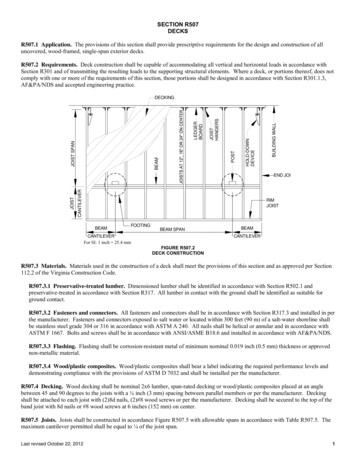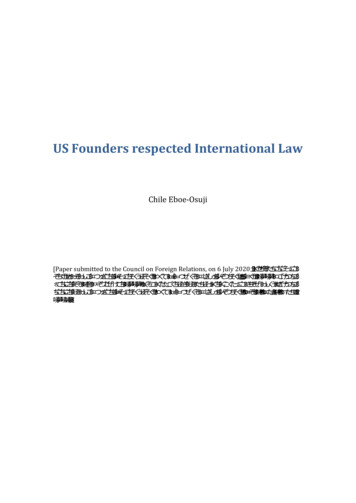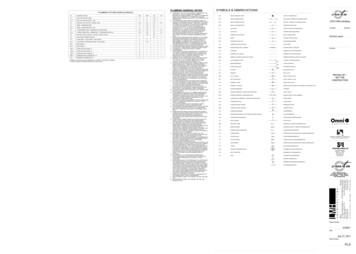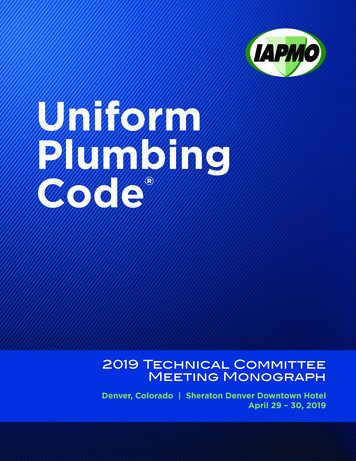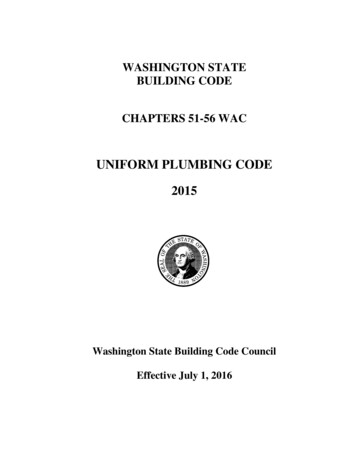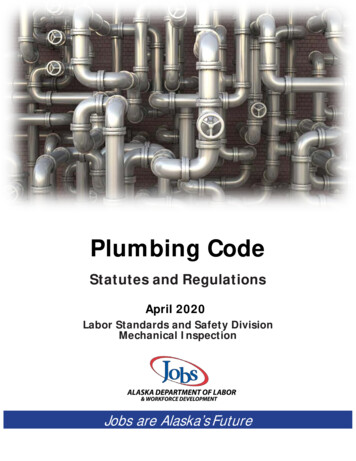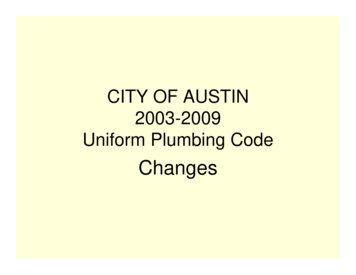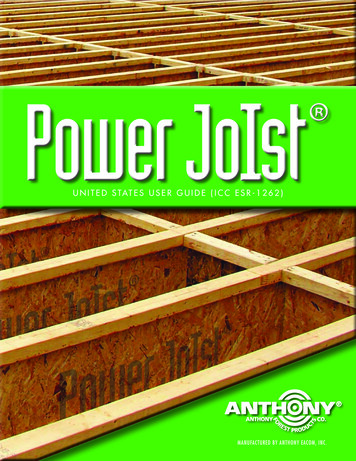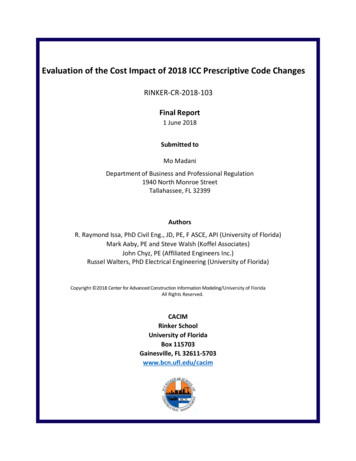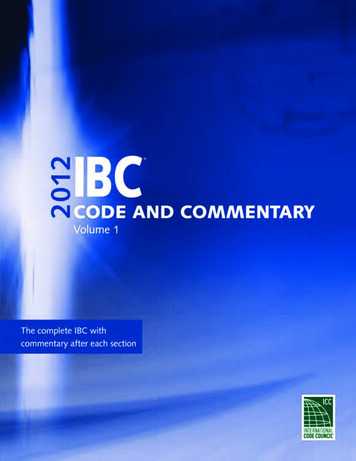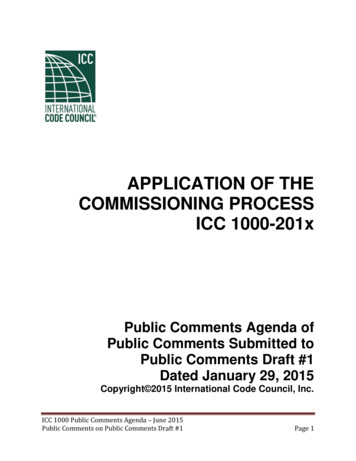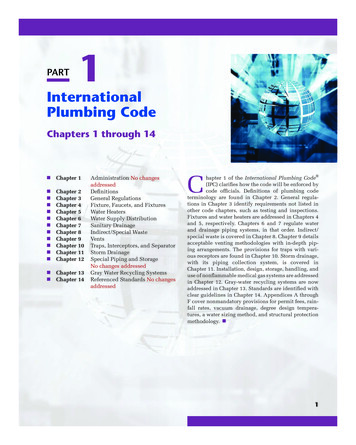
Transcription
PART1InternationalPlumbing CodeChapters 1 through 14 Chapter 1 Chapter 2Chapter 3Chapter 4Chapter 5Chapter 6Chapter 7Chapter 8Chapter 9Chapter 10Chapter 11Chapter 12 Chapter 13Chapter 14142474 pt01 ptg01 hr 001-071.indd 1Administration No changesaddressedDefinitionsGeneral RegulationsFixture, Faucets, and FixturesWater HeatersWater Supply DistributionSanitary DrainageIndirect/Special WasteVentsTraps, Interceptors, and SeparatorStorm DrainageSpecial Piping and StorageNo changes addressedGray Water Recycling SystemsReferenced Standards No changesaddressedhapter 1 of the International Plumbing Code (IPC) clarifies how the code will be enforced bycode officials. Definitions of plumbing codeterminology are found in Chapter 2. General regulations in Chapter 3 identify requirements not listed inother code chapters, such as testing and inspections.Fixtures and water heaters are addressed in Chapters 4and 5, respectively. Chapters 6 and 7 regulate waterand drainage piping systems, in that order. Indirect/special waste is covered in Chapter 8. Chapter 9 detailsacceptable venting methodologies with in-depth piping arrangements. The provisions for traps with various receptors are found in Chapter 10. Storm drainage,with its piping collection system, is covered inChapter 11. Installation, design, storage, handling, anduse of nonflammable medical gas systems are addressedin Chapter 12. Gray-water recycling systems are nowaddressed in Chapter 13. Standards are identified withclear guidelines in Chapter 14. Appendices A throughF cover nonmandatory provisions for permit fees, rainfall rates, vacuum drainage, degree design temperatures, a water sizing method, and structural protectionmethodology. C16/29/11 12:54 PM
202417.5.2.6Plumbing Fixture DefinitionShower Pan Liner Materials202424.9Plumbing Appliance DefinitionWater Closet Personal Hygiene Devices202504.4.1Grease Interceptor DefinitionWater Heater Storage Tank Relief Valves303.1, 303.4504.7Material Identification and Third-PartyCertificationWater Heater Pans308.9605Parallel Water Distribution SystemsPolyethylene of Raised-Temperature (PE-RT)Plastic Tubing315.1TA B L E 6 0 5 . 3Sealing of Annular Spaces at PenetrationsPolyethylene (PE) Water Service PipeTA B L E 4 0 3 . 1TA B L E 6 0 5 . 3Minimum Number of Required Plumbing FixturesPEX Water Service Pipe403.2606.7Separate Toilet Facilities in Group M OccupanciesLabeling of Water Distribution Pipes in Bundles403.2.1607.1.1Family or Assisted-Use Toilet Facilities Serving asSeparate FacilitiesWater-Temperature-Limiting Means403.3.2Relationship of Toilet Rooms and Food PreparationAreas403.3.6Locking of Toilet Room Doors403.5Drinking Fountain Locations405.3.1Minimum Water Closet Compartment Size405.4607.2Hot or Tempered Water Supply to Fixtures607.5Hot Water Piping Insulation608.8Identification of Nonpotable Water704.3, 711.2.1Horizontal Branch ConnectionsTA B L E 7 0 9 . 1Drainage Fixture Units for Bathroom GroupsFloor and Wall DrainageConnections712.3.3407.2712.3.5Bathtub Waste Outlets and OverflowsSump Pump Connection to the Drainage System410715.1Minimum Required Number of Drinking FountainsFixture Protection from Sewage BackflowSump Pump and Ejector Discharge Pipe and Fittings2S GN S42474 pt01 ptg01 hr 001-071.indd 2C SO6/29/11 12:54 PM
802.1.81002.1Indirect Discharge of Food Preparation SinksFloor Drains in Multi-Level Parking Structures802.21003.1Installation of Indirect Waste PipingInterceptors and Separators802.31003.3.1Prohibited Locations for Waste ReceptorsAlternate Grease Interceptor Locations901.3, 918.81003.3.4Air Admittance Valves for Chemical Waste VentSystemsHydromechanical Grease Interceptors903.5Location of Vent Terminals915.2Combination Waste and Vent System Sizing9171105Roof Drain Strainers1107Siphonic Roof Drainage SystemsCHAPTER 13Gray-Water Recycling SystemsSingle-Stack Vent Systems342474 pt01 ptg01 hr 001-071.indd 336/29/11 12:54 PM
4PART 1 International Plumbing Code202CHANGE TYPE:Plumbing FixtureDefinitionCHANGE SUMMARY: The definition of “plumbing fixture” has beenmodified to include fixtures such as waterless urinals.ModificationInternational Code Council 2012 CODE: Plumbing Fixture. A receptacle or device that is eitherpermanently or temporarily connected to the a water distribution supplysystem or of the premises and demands a supply of water therefrom;discharges wastewater, liquid-borne waste materials or sewage eitherdirectly or indirectly to a the drainage system of the premises; or requiresboth. Such receptacles or devices require a water supply of water;connection and a or discharge liquid waste or liquid-borne solid waste;or require a supply of water and discharge waste to a the drainage systemof the premises.CHANGE SIGNIFICANCE: The previous definition of “plumbing fixture”was outdated and incomplete. The definition now includes receptaclesand devices that do not necessarily require connection to a watersupply. Waterless urinals and floor drains, now addressed in the reviseddefinition, were not defined as plumbing fixtures in the past.Waterless urinalS GN S42474 pt01 ptg01 hr 001-071.indd 4C SO6/29/11 12:54 PM
Significant Changes to the IPC 2012 EditionCHANGE TYPE:202ClarificationCHANGE SUMMARY: The definition of “plumbing appliance” has beenchanged to clarify the difference between appliances and fixtures. Plumbing Appliance Definition5202Plumbing ApplianceDefinition2012 CODE: Plumbing Appliance. Any one of a special class ofplumbing fixtures Water-connected or drain-connected devices intendedto perform a special function. Included are fixtures having the Thesedevices have their operation or control dependent on one or moreenergized components, such as motors, controls, or heating elementsor pressure or temperature sensing elements. Such fixtures devices aremanually adjusted or controlled by the owner or operator, or are operatedautomatically through one or more of the following actions; a time cycle,a temperature range, a pressure range, a measured volume or weight.International Code Council CHANGE SIGNIFICANCE: The modified definition of “plumbingappliance” provides a better distinction between appliances and fixtures.The revised text updates and simplifies the definition, now recognizingthese two classes as different. Examples of plumbing appliances includedishwashers, clothes washers, garbage disposals, water softeners, waterpurifiers, and water heaters.Domestic garbage disposal42474 pt01 ptg01 hr 001-071.indd 56/29/11 12:54 PM
6PART 1 International Plumbing Code202CHANGE TYPE:Grease InterceptorDefinitionCHANGE SUMMARY: The definition of “grease interceptor” has beenmodified for consistency with current industry terms for the two generaltypes of grease interceptors being used in plumbing installations.Modification2012 CODE: Grease Interceptor. A plumbing appurtenance that isinstalled in a sanitary drainage system to intercept oily and greasy wastesfrom a wastewater discharge. Such device has the ability to intercept freefloating fats and oils.Grease Interceptor.Hydromechanical. Plumbing appurtenances that are installedin the sanitary drainage system to intercept free-floating fats, oilsand grease from wastewater discharge. Continuous separation isaccomplished by air entrainment, buoyancy and interior baffling.Gravity. Plumbing appurtenances of not less than 500 gallons(1893 L) capacity that are installed in the sanitary drainagesystem to intercept free-floating fats, oils and grease fromwastewater discharge. Separation is accomplished by gravityduring a retention time of not less than 30 minutes.The installation of a typicalhydromechanical greaseinterceptor (Courtesy of Thermaco,6" thickconcrete padInc. 2010 )Solid manhole coverGrade or pavingSteps36" diameterprecastmanholebarrel sectionAs required7"Precastconcretegreaseinterceptor24"10" COOutletCast irontee withcleanoutplugWaterlevel12"Cast ironlong 1/4 bend8"Concrete baffleInternational Code Council InletGrout(typical)Typical concrete grease interceptorS GN S42474 pt01 ptg01 hr 001-071.indd 6C SO6/29/11 12:54 PM
Significant Changes to the IPC 2012 Edition202 Grease Interceptor Definition7CHANGE SIGNIFICANCE: The provisions of Section 1003.3.4 addressinggrease interceptors and automatic grease removal devices were neverintended to apply to gravity grease interceptors. The new terminology nowmakes a clear distinction between the two types of grease interceptors,hydromechanical and gravity. The revision to the definition along withthe changes made in Section 1003.3.4 place the IPC in better alignmentwith product standards and industry terminology. Both types of greaseinterceptors require diligent effort by restaurant facility managers and staffto ensure that they are regularly maintained and properly serviced. For agrease collection device to work correctly, it must be properly designed,installed, maintained, and serviced regularly.42474 pt01 ptg01 hr 001-071.indd 76/29/11 12:54 PM
8PART 1 International Plumbing Code303.1, 303.4CHANGE TYPE:Material Identificationand Third-PartyCertificationCHANGE SUMMARY: The identification requirements for plumbingproducts and materials have been clarified.Clarification2012 CODE: 303.1 Identification. Each length of pipe and eachpipe fitting, trap, fixture, material, and device utilized in a plumbingsystem shall bear the identification of the manufacturer and any markingsrequired by the applicable referenced standards.303.4 Third-Party Testing and Certification. All plumbing productsand materials shall comply be listed by a third-party certification agencyas complying with the referenced standards, specifications and performance criteria of this code. and shall be identified in accordance withSection 303.1. When required by Table 303.4, plumbing products and materials shall either be tested by an approved third–party testing agency orcertified by an approved third–party certification agency. Products andmaterials shall be identified in accordance with Section 303.1.TABLE 303.4 Products and Materials Requiring Third-Party Testingand Third-Party CertificationProduct or MaterialThird-Party CertifiedThird-Party TestedPotable water supplysystem componentsand potable water fixturefittingsRequired–Sanitary drainage andvent system componentsPlastic pipe, fittings andpipe-related componentsAll OthersWaste fixture fittingsPlastic pipe, fittings andpipe-related componentsAll OthersStorm drainage systemcomponentsPlastic pipe, fittings andpipe-related componentsAll OthersPlumbing fixtures–RequiredPlumbing appliancesRequired–Backflow preventiondevicesRequired–Water distributionsystem safety devicesRequired–Special waste systemcomponents–RequiredSubsoil drainage systemcomponents–RequiredS GN S42474 pt01 ptg01 hr 001-071.indd 8C SO6/29/11 12:54 PM
Significant Changes to the IPC 2012 Edition303.1, 303.4 Material Identification9PEX tubing label with complete identification and conformance information (Courtesy of Uponor Corporation)CHANGE SIGNIFICANCE: The modification to the identificationprovisions of Section 303.1 clarifies the intent of the code that productsand materials shall bear the identification of the manufacturer, as wellas the identification requirements that are referenced by the applicablestandard. As a result of the modifications made to Section 303.4, allplumbing products and materials must now be listed by a third-partycertification agency. Table 303.4 was deleted as a result of the modificationsmade to Section 303.4.42474 pt01 ptg01 hr 001-071.indd 96/29/11 12:54 PM
10PART 1 International Plumbing Code308.9CHANGE TYPE:Parallel WaterDistribution SystemsCHANGE SUMMARY: In parallel water distribution systems, the hotand cold water piping may now be grouped in the same pipe bundle.Modification2012 CODE: 308.9 Parallel Water Distribution Systems. Pipingbundles for manifold systems shall be supported in accordance withTable 308.5. Support at changes in direction shall be in accordance withthe manufacturer’s installation instructions. Where Hhot and cold waterpiping shall not be grouped in the same is bundled with cold or hot waterpiping, each hot water pipe shall be insulated.CHANGE SIGNIFICANCE: Hot water piping is now permitted to bebundled together with other cold or hot water piping. However, thisinstallation method is only permitted where each hot water pipe isinsulated. Only one of the hot water pipes in a parallel water distributionsystem actually has hot water running through it at any given time. Theother hot water pipes have cold water sitting in them and heat transferbetween the hot pipe being used and the other piping will take place.Manifold plumbing systems are control centers for hot and cold waterthat feed flexible PEX supply lines to individual fixtures. Cold water andun-insulated hot water piping in the same bundles are known to absorblarge amounts of heat. This code modification will prevent this costlyheat transfer.International Code Council Hot waterHot waterTempered waterExample of insulated bundle pipingS GN S42474 pt01 ptg01 hr 001-071.indd 10C SO6/29/11 12:54 PM
315.1Significant Changes to the IPC 2012 EditionCHANGE TYPE: 11Sealing of Annular Spaces at Penetrations315.1ModificationCHANGE SUMMARY: The provisions for sealing any annular spacescreated at piping penetrations have been revised to be consistent withthe building envelope sealing requirements of the International EnergyConservation Code.Sealing of AnnularSpaces at Penetrations2012 CODE: 305.4 315.1 Sleeves Sealing of Annular Spaces. Theannular spaces between the outside of a pipe and the inside of a pipesleeves, and pipes or between the outside of a pipe and an openingin a building envelope wall, floor, or ceiling assembly penetrated bya pipe shall be filled or tightly caulked sealed in an approved mannerwith caulking material or closed with a gasketing system. The caulkingmaterial, foam sealant, or gasketing system shall be designed for theconditions at the penetration location and shall be compatible with thepipe, sleeve and building materials in contact with the sealing ma
hapter 1 of the International Plumbing Code (IPC) clarifi es how the code will be enforced by code offi cials. Defi nitions of plumbing code terminology are found in Chapter 2. General regula-tions in Chapter 3 identify requirements not listed in other code chapters, such as testing and inspections.
